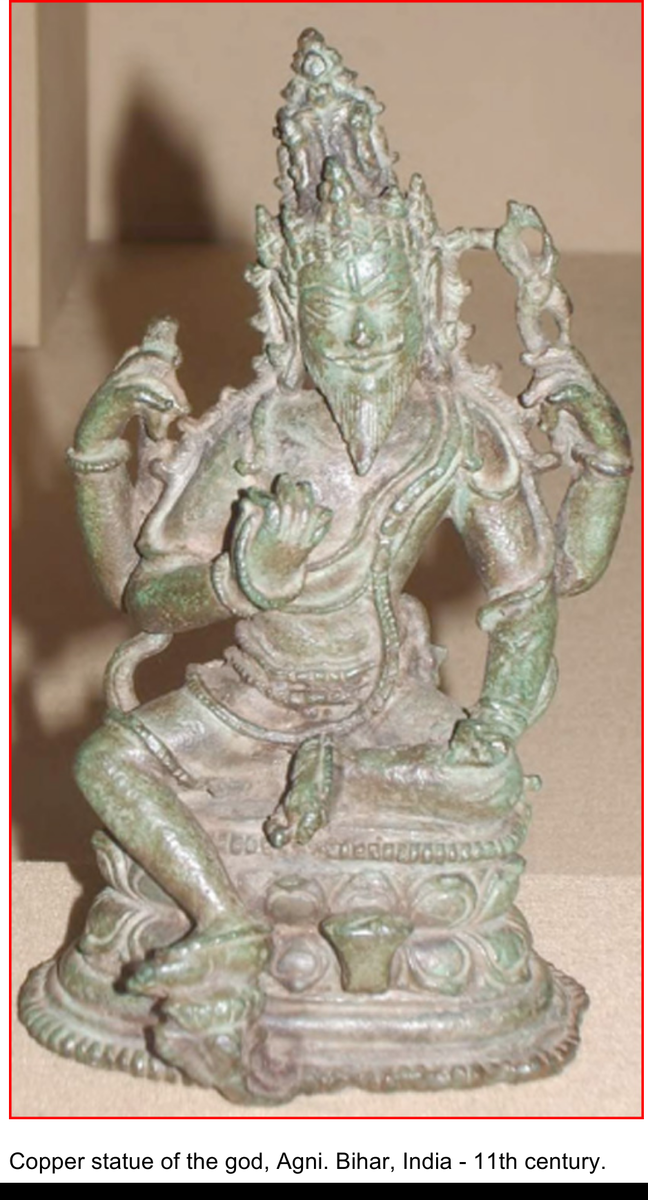[The Nature of Nature Gods 自然の神々の性質]

神の銅像、アグニ。 インド、ビハール-11世紀。
――――――――
Dec 19, 2007
古代の神話は、神のようなアイデンティティを自然の力に帰しています。 それらはプラズマ現象の表現とする事は可能でしょうか?
神話の辞書は、アグニを「火の神」と定義する言葉を無駄にすることはありません、これは、自宅での居心地の良い暖炉の火から、屋外で観察される最も壊滅的な落雷まで、あらゆる自然の火の現れにカプセル化された自然の生命力です。
しかし、神話上の神のそのような標準的な定義は、どれだけを私たちに教えてくれるでしょうか?
アグニのような神話的で宗教的な性格を、神話での活動ではなく、主に自然界での彼の共通の外見の観点から認定することは、いわゆる「自然学派」の神話を反映しています。
この学派は19世紀後半に全盛期を迎えましたが、辞書のエントリに反映されているように、今日の神話上の実体の一般的な理解に消えない印を残しています。
それぞれの文化におけるそれぞれの神話上の神は、自然界または人間社会のある側面の比喩として始まったという仮定から始まり、無数のよく知られた定義が生まれました。
ゼウス、「空の神」、ヘファイストス、「火の神」、ヘリウス、「太陽の神」、ポセイドン、「海の神」、アフロディーテ、「愛の女神」、アルテミス、「狩猟の女神」 、そしてアレス、「戦争の神」は、古代人自身がこれらの神を見ていた方法の何かを反映しているのでしょうか?
神話のような複雑で「流動的な」主題では、簡単な過度の一般化を提供するよりも、歴史的な傾向と地理的パターンを特定する方が適切です。
ヘレニズム時代(紀元前4世紀)以降のギリシャの思想家は、確かに自然と文化の領域を1対1で神にきちんと対応するセクションに区分する傾向がありました。
一部のローマの神話学者達は、これを極端に扱い、人生で考えられるあらゆる活動の最も微妙な側面について特定の神に名前を付けたことで有名です。
しかし、これらの合理的な努力は、実際には、重複し矛盾するデータ神話の計り知れないウェルター(寄せ集め)の考案された二次的な体系化にすぎません。
比較神話学者達は、特定の神または女神のカルトと神話をよく見るほど、簡単な辞書の定義と「事実」との間の不一致が大きくなることを知っています。
過去にさかのぼるほど、次の2つの傾向が強くなります。
第一に、異なる神々の間の境界が消え、多くの神々がお互いの複製のように見え始めます。
そして第二に、古代のテキストは、自然の定義の観点から彼らの神々を「定義する」努力をすることはめったにありません。
代わりに、これらの神々の「行為」と「見た目」の詳細な物語が提供されます。
神話の古風な状態は、神々の崇拝が自然を分類する意識的な試みとはほとんど関係がなかったという強い印象を与えます。
代わりに、それは人類が今日めったに経験しない自然の力で経験した一連の非常に印象的で、間違いなくトラウマを与える経験から直接流れ出ました。
当初から、「神々」と「女神」は、危険なほど活発な空で観察された認識可能で活発な力の単なるラベルでした。
静かな空を見ている人々が、彼らが受け継いだ記憶された習慣や伝統の寄せ集めから合理的なパラダイムを抽出し始めたのは、それからずっと後のことでした。
神々の慣習的な辞書の定義は正確に間違っているわけではありませんが、これらの神々が単なる俳優であるという神話上の出来事を損なう傾向があります。
「神々の性質」についての先入観を中断し、神話自体に耳を傾けることができる人は誰でも、世界軸、または世界軸が重要な役割を果たす創造神話のサイクルに繰り返し引き付けられます。
初期のヴェーダのテキストでは、アグニは確かに火を意味しますが、これは具体的には「世界のへそ」を象徴的にマークした祭壇から立ち上がった火と煙の柱です:
「彼は熱心に立ち上がって、しっかりと固定され、犠牲者に油を注ぐ、新しく作られた柱のようになります。」
この蒸気の柱は、生命の木に他なりません:
「他の火は、まことに、あなたの枝です;
アグニよ、不死者たちはみなあなたを喜ばせます。
人々の中心となる汝、ヴァイシュヴァナラは、根深い柱のように男性を支えています。
空の額、地球の中心、アグニは地球と天国のメッセンジャーになりました。」
近年、神話とプラズマ物理学の学際的な研究により、地球の大気と電離層で観察される非常に珍しい電磁イベントが、古代の創造神話の視覚的内容の大部分をうまく説明できることが示唆されています。
これを考慮すると、将来の神話学者達にとって、神話上の出来事自体の「全体像」ほど、神々の個々の「伝記」に集中しないことは、特に、異文化間の神話上の原型によって提案された視覚的なテンプレートについて有益であることがわかるかもしれません。
Contributed by Rens Van der Sluijs
レンズ ファン・デル スルージスによる寄稿
――――――――
Dec 19, 2007
Ancient mythology ascribes godlike identities to the forces of nature. Could they be representations of plasma phenomena?
古代の神話は、神のようなアイデンティティを自然の力に帰しています。 それらはプラズマ現象の表現とする事は可能でしょうか?
No dictionary of mythology will waste any words defining Agni as 'the god of fire', the living force of nature encapsulated in any and all natural manifestations of fire, ranging from the cozy hearth fire at home to the most devastating lightning strikes observed outside.
神話の辞書は、アグニを「火の神」と定義する言葉を無駄にすることはありません、これは、自宅での居心地の良い暖炉の火から、屋外で観察される最も壊滅的な落雷まで、あらゆる自然の火の現れにカプセル化された自然の生命力です。
But just how much does such a standard definition of a mythical god tell us?
しかし、神話上の神のそのような標準的な定義は、どれだけを私たちに教えてくれるでしょうか?
To qualify a mythical and religious character such as Agni primarily in terms of his common appearance in nature, not in terms of his activities in myth, is a reflection of the so-called 'nature school' of myth.
アグニのような神話的で宗教的な性格を、神話での活動ではなく、主に自然界での彼の共通の外見の観点から認定することは、いわゆる「自然学派」の神話を反映しています。
This school saw its heyday in the late 19th century but has left an indelible stamp on the popular understanding of mythical entities today, as reflected in dictionary entries.
この学派は19世紀後半に全盛期を迎えましたが、辞書のエントリに反映されているように、今日の神話上の実体の一般的な理解に消えない印を残しています。
Starting from the assumption that each mythical deity in each culture originated as a metaphor for some aspect of the natural world or of human society, countless familiar definitions arose.
それぞれの文化におけるそれぞれの神話上の神は、自然界または人間社会のある側面の比喩として始まったという仮定から始まり、無数のよく知られた定義が生まれました。
Do Zeus, 'the sky god', Hephaestus, 'the fire god', Helius, 'the sun god', Poseidon, 'the sea god', Aphrodite, 'the goddess of love', Artemis, 'the goddess of hunting', and Ares, 'the god of war' reflect anything of the way the ancients themselves looked at these gods?
ゼウス、「空の神」、ヘファイストス、「火の神」、ヘリウス、「太陽の神」、ポセイドン、「海の神」、アフロディーテ、「愛の女神」、アルテミス、「狩猟の女神」 、そしてアレス、「戦争の神」は、古代人自身がこれらの神を見ていた方法の何かを反映しているのでしょうか?
With a complex 'fluid' subject such as mythology, it is better to identify historical tendencies and geographic patterns than to offer facile over-generalizations.
神話のような複雑で「流動的な」主題では、簡単な過度の一般化を提供するよりも、歴史的な傾向と地理的パターンを特定する方が適切です。
Greek thinkers from the Hellenistic period (4th century BCE) onwards certainly tended to compartmentalize the realms of nature and culture into sections that would neatly correspond to divinities on a one-to-one basis.
ヘレニズム時代(紀元前4世紀)以降のギリシャの思想家は、確かに自然と文化の領域を1対1で神にきちんと対応するセクションに区分する傾向がありました。
Some Roman mythologists famously took this to extremes, naming specific gods for the most nuanced aspects of any conceivable activity in life.
一部のローマの神話学者達は、これを極端に扱い、人生で考えられるあらゆる活動の最も微妙な側面について特定の神に名前を付けたことで有名です。
But these rational efforts really reflect no more than a contrived and secondary systematization of the unfathomable welter of overlapping and contradictory data mythology really is.
しかし、これらの合理的な努力は、実際には、重複し矛盾するデータ神話の計り知れないウェルター(寄せ集め)の考案された二次的な体系化にすぎません。
The comparative mythologist knows that the closer you look at the cult and myth of any given god or goddess, the greater the discrepancy between the straightforward dictionary definition and the 'facts'.
比較神話学者達は、特定の神または女神のカルトと神話をよく見るほど、簡単な辞書の定義と「事実」との間の不一致が大きくなることを知っています。
The further one goes back in time, the stronger the following two tendencies.
過去にさかのぼるほど、次の2つの傾向が強くなります。
Firstly, the boundaries between different deities disappear and many begin to look like duplicates of each other.
第一に、異なる神々の間の境界が消え、多くの神々がお互いの複製のように見え始めます。
And secondly, the ancient texts rarely make an effort to 'define' their gods in terms of nature definitions.
そして第二に、古代のテキストは、自然の定義の観点から彼らの神々を「定義する」努力をすることはめったにありません。
Instead, one is just offered detailed stories of the 'deeds' and 'looks' of these gods.
代わりに、これらの神々の「行為」と「見た目」の詳細な物語が提供されます。
The archaic state of mythology gives the strong impression that the worship of deities had little to do with a conscious attempt to categorize nature.
神話の古風な状態は、神々の崇拝が自然を分類する意識的な試みとはほとんど関係がなかったという強い印象を与えます。
Instead, it directly flowed forth from a series of extremely impressive, arguably traumatizing experiences mankind had had with forces of nature rarely experienced today.
代わりに、それは人類が今日めったに経験しない自然の力で経験した一連の非常に印象的で、間違いなくトラウマを与える経験から直接流れ出ました。
From the start, the 'gods' and 'goddesses' were merely labels for recognizable and active forces observed in a dangerously active sky.
当初から、「神々」と「女神」は、危険なほど活発な空で観察された認識可能で活発な力の単なるラベルでした。
It was only long afterwards that people looking at a quiescent sky began to extract rational paradigms from the jumble of remembered customs and traditions they had inherited.
静かな空を見ている人々が、彼らが受け継いだ記憶された習慣や伝統の寄せ集めから合理的なパラダイムを抽出し始めたのは、それからずっと後のことでした。
While the customary dictionary definitions of deities are not exactly wrong, they tend to detract from the mythical events in which these gods are merely actors.
神々の慣習的な辞書の定義は正確に間違っているわけではありませんが、これらの神々が単なる俳優であるという神話上の出来事を損なう傾向があります。
Whoever can suspend any preconceived ideas about the 'nature of the gods' and listens in to the myths themselves will repeatedly be drawn to the cycle of creation myths, in which the axis mundi or world axis plays the prominent role.
「神々の性質」についての先入観を中断し、神話自体に耳を傾けることができる人は誰でも、世界軸、または世界軸が重要な役割を果たす創造神話のサイクルに繰り返し引き付けられます。
In the earliest Vedic texts, Agni surely signifies fire, but this is specifically the column of fire and smoke that rose up from the altar that symbolically marked the 'navel of the world':
"Eager he rises like the new-wrought pillar which, firmly set and fixed, anoints the victims."
初期のヴェーダのテキストでは、アグニは確かに火を意味しますが、これは具体的には「世界のへそ」を象徴的にマークした祭壇から立ち上がった火と煙の柱です:
「彼は熱心に立ち上がって、しっかりと固定され、犠牲者に油を注ぐ、新しく作られた柱のようになります。」
This vaporous column is none other than the tree of life:
"The other fires are, verily, thy branches;
the Immortals all rejoice in thee, O Agni.
この蒸気の柱は、生命の木に他なりません:
「他の火は、まことに、あなたの枝です;
アグニよ、不死者たちはみなあなたを喜ばせます。
Center art thou, Vaiśvānara, of the people, sustaining men like a deep-founded pillar.
人々の中心となる汝、ヴァイシュヴァナラは、根深い柱のように男性を支えています。
The forehead of the sky, earth's center, Agni became the messenger of earth and heaven."
空の額、地球の中心、アグニは地球と天国のメッセンジャーになりました。」
In recent years, an interdisciplinary study of mythology and plasma physics has suggested that highly uncommon electromagnetic events observed in the earth's atmosphere and ionosphere could successfully account for a large segment of the visual content of ancient creation mythology.
近年、神話とプラズマ物理学の学際的な研究により、地球の大気と電離層で観察される非常に珍しい電磁イベントが、古代の創造神話の視覚的内容の大部分をうまく説明できることが示唆されています。
In view of this, it may prove fruitful for future mythologists not to concentrate so much on the individual 'biographies' of the gods as on the 'bigger picture' of the mythical events themselves, specifically on the visual templates suggested by cross-cultural mythical archetypes.
これを考慮すると、将来の神話学者達にとって、神話上の出来事自体の「全体像」ほど、神々の個々の「伝記」に集中しないことは、特に、異文化間の神話上の原型によって提案された視覚的なテンプレートについて有益であることがわかるかもしれません。
Contributed by Rens Van der Sluijs
レンズ ファン・デル スルージスによる寄稿